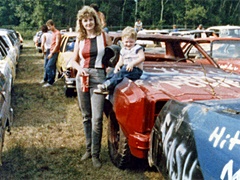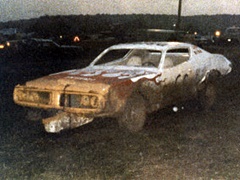
Welcome to Hemlock and Canadice Lakes!
Barns Businesses Cemeteries Churches Clinton & Sullivan Columns Communities Documents Events Time Line Fairs & Festivals Farm & Garden Hiking Homesteads Lake Cottages Lake Scenes Landscapes Library News Articles Old Maps Old Roads & Bridges Organizations People Photo Gallery Podcasts Railroad Reservoir Schools State Forest Veterans Videos
|
“Hemlock Stories” by Ira Briggs |
|
|
A Brief History of the Hemlock Demolition Derby By Ira Briggs 25 June 2013 1 The line up before the demolition derby at the Hemlock Fair. In the ‘60s there were two car thrill shows that would alternate yearly at the Hemlock Fair. One was orchestrated by Joey Chitwood and sponsored by Chevrolet. The other was sponsored by Ford and run by Stoney Roberts, a one-armed stunt man. My friends and I speculated as to how Stoney had lost his left arm and how cool it was that he could still perform stunts with his disability. Even though his loss remains a mystery, I still tell my son, “Keep your arms in the vehicle at all times—don’t forget Stoney!” Chitwood and Roberts each had their own crew of stunt drivers who entertained the crowd with similar stunts. There would be a new 1967 Camaro shooting out of a huge cannon, in hopes of landing on the exiting ramp, a car driving on the side walls of its two right wheels around the track, and a motorcycle driving through a burning wooden wall. (For extra effect, the stunt cyclist would apply gasoline to his fire-retardant jacket that would ignite upon impact.) Prior to the fair, the thrill show promoters would contact local automotive related businesses. Generally, Fugle’s or Rossburough’s would provide a few non-road worthy vehicles for use in the T-bone crash and ramp jumps. In return, they would receive free advertising on the fair’s P.A. system. Because my dad (Larry) operated a garage adjacent to the fairgrounds, it was advantageous for Chitwood and Roberts to have various repairs and welding done at his shop. By the late ‘60s, the novelty of the thrill show had waned, as spectators tired of the same routine. During one of Stoney Robert’s conversations with my dad, he expressed his concern that sponsors weren’t as willing to provide new vehicles any more. He related that the southern states had developed a new form of entertainment called “The Demolition Derby.” The concept was, let local individuals be the star of the show by smashing into each other in a confined corralled area (often disposing of the family’s well-worn car in the process). Last one running wins. Dad presented Stoney’s proposal to Cy Day, President of the Fair Society, and its members. They unanimously approved and the Demo was thus conceived. Rules were established and criteria enforced to minimize danger and enhance safety. Local auto enthusiasts Larry Coykendall and Dave Connor were two of the early notable long-standing Demo Crew Chiefs. Betty Gaskin is believed to be the first female Demo driver. The most memorable Demo car that comes to mind was a 1960 Thunderbird with its futuristic interior and exterior design. It wasn’t of much value at the time, but it grieves me to think of how the driver drove in, removed the license plates, kicked out the windshield, removed the outside chrome and headlights and wired the doors shut. It was ready to go. Scrap metal was at an all-time low during this era; therefore, the majority of drivers would opt to leave their cars at the fairground after the Demo. At the age of 13, living next to the fairgrounds, my friends and I were as excited to see the fair go as we were to see it come. The end meant that all cars left on the fairgrounds were up for grabs. Often they would only need minor repair, such as a battery connection, fuel line repair, or distributor cap to render them operable. It was a great mechanical trouble shooting education for adolescents. After a month or two, our Demo cars would develop more serious problems and it would no longer be feasible to repair them. 2 Ira’s 1971 Demo car. Throughout the following seasons, individuals would pick parts off the Demo cars behind my house. I even recall a group of guys going to the extreme of removing a 327 cubic inch engine from a 1964 Chevy Impala. By the next fair time, local salvage yards would be paid to remove the cannibalized cars before the event. Like most of the locals, I wasn’t immune to the lure of showmanship. Of all the cars I drove in the Demo, the one that stands out as having the most collectable value today was a 1971 Dodge Charger. It was starting to relinquish its steel due to road salt, but all in all it was a fairly solid car. To my knowledge, the Hemlock Fair was the first promoter to provide this type of entertainment in New York State. The 2013 Hemlock Fair runs July 16 - 20. Demo Derby Nights are Tues. and Sat. Drivers ages 16 - 17 will be able to compete Tuesday night. Visit hemlockfair.org for more information.
|
||
|
Editor’s Note: Ira Briggs is a well digger, writer and Arc Living Skills Assistant and a University of Rochester employee who hails from Hemlock. He writes short stories from his memories of the people and events of Hemlock NY.
|
||

